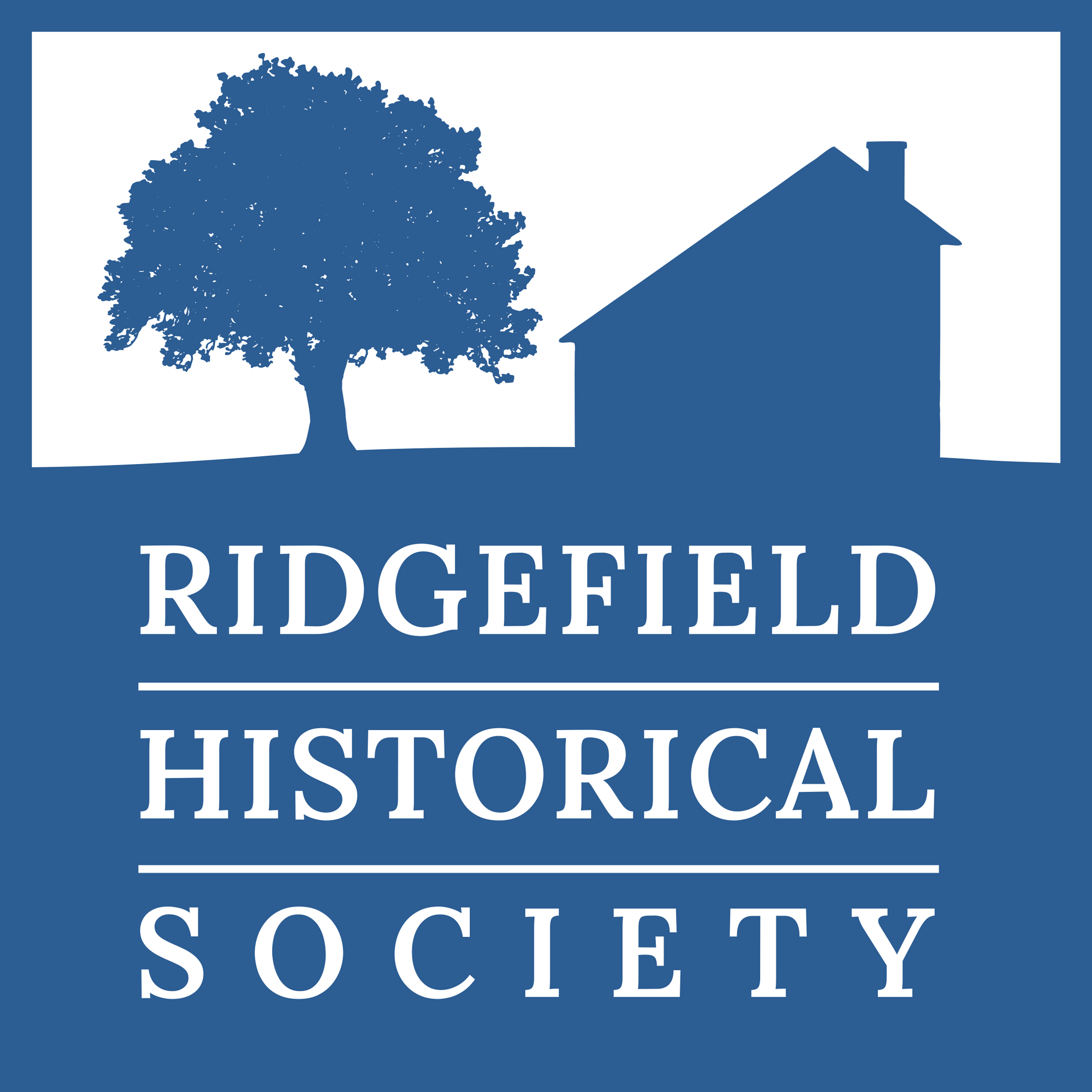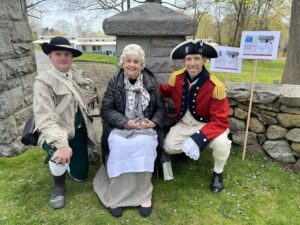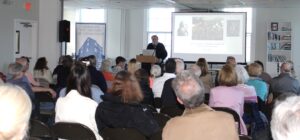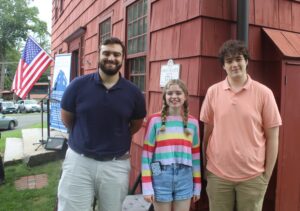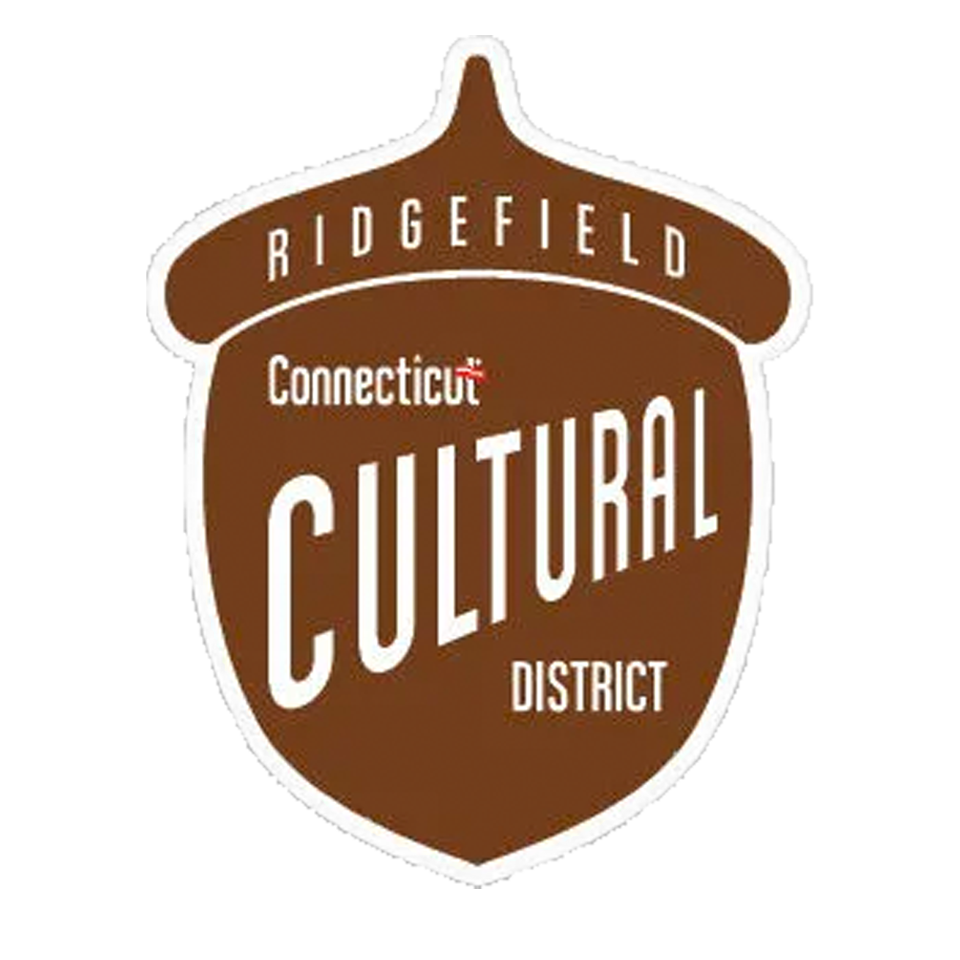Download PDF
A family’s collection is a treasure for historians
Generations of the Couch family add detail through documents, letters, photographs, etc.
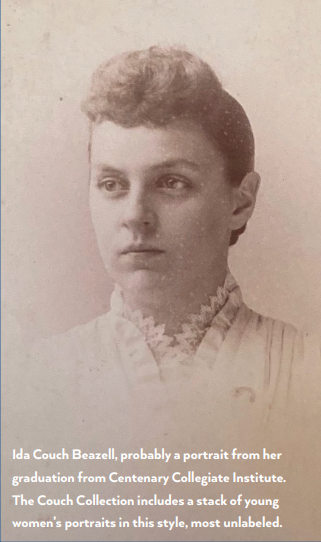 A surprise for historian Jack Sanders, who has been researching the Ridgefield district schools: The frugal school committee of the Whipstick District School even sold the ashes from the school’s stove (for fertilizer) to raise funds, a practice he’d not encountered in other Ridgefield districts, nor in other histories of one-room schools.
A surprise for historian Jack Sanders, who has been researching the Ridgefield district schools: The frugal school committee of the Whipstick District School even sold the ashes from the school’s stove (for fertilizer) to raise funds, a practice he’d not encountered in other Ridgefield districts, nor in other histories of one-room schools.
It’s hardly an earth-shaking discovery, but what may have seemed ordinary in its day is the stuff that fills in the picture of how Ridgefielders lived their lives two centuries ago. The school committee minutes also include details of how teachers were hired and for what compensation.
One instance shows how difficult it was to be a school mistress. The school committee voted in March 1806 to hire Mrs. Abigail Rockwell at one dollar and 25 cents per week plus board. By June of that year the committee apparently thought better of the pay rate and there was a vote to set her pay at one dollar a week. The committee refused to raise her pay and she declined the position. The committee then agreed to offer the position to Mrs. Esther Beers “provided she can be obtained for one dollar per week,” with board. Failing that, the committee was directed to “apply to some other suitable person.”
Saved for the future
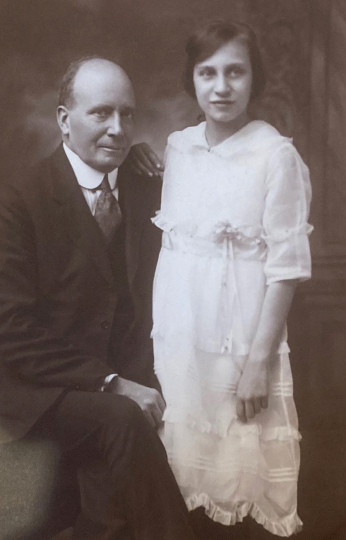
The vault in the David Scott House, the Ridgefield Historical Society’s headquarters on Sunset Lane, houses many troves of material, but one that’s remarkable for sheer variety as well as volume is the Couch family collection, where the Whipstick District records reside.
The materials were offered to the nascent historical society more than 20 years ago. They were retrieved from a Couch descendant in Pennsylvania by the intrepid Jeanne Timpanelli, then a member of the archives committee of the Ridgefield Preservation Trust. She was a leader of the campaign to save the David Scott House and turn it into the Ridgefield Historical Society headquarters as the 21st Century began.
The contents of this collection include more than 2,000 letters (dating back to 1805), as well as records of the 8th (Whipstick) School District from 1798 to 1871, a Ridgefield tax collector’s booklet from 1853, material from the Ridgefield Agricultural Society, an 1871 broadside from the Ridgefield Floral Society, three military commissions signed by Gov. Oliver
Wolcott, and a letter of recommendation signed by Noah Webster. In addition, there were several books on genealogy and local history included in the collection.
Sorting and cataloging all this material is an interesting challenge for the volunteers and staff at the Ridgefield Historical Society. As photos and documents and letters are sorted, they are placed into archival “sleeves” of a clear plastic that will protect them; each item is recorded with a number and a description so that when it’s ready to be entered into the collections database, it will include as much information as possible.
The family accumulated stacks of photographic “cabinet cards” – cardboard-backed portraits that were popular in the late 19th Century. Unfortunately, the large percentage of the subjects are unidentified.
(A reminder to all of us: Please identify the subject of photos on the photo. Or include the information in the digital image’s file name. Your descendants, and possibly some future historian or genealogist, thank you!)
Going through these photographic memories, volunteers become detectives: looking for familiar faces, linking one person to another, learning about the clothing and hairstyles that can date a picture, seeing how a person can change over the course of years. The images may not be identified now, but it’s not much of a stretch to think that a future computer program may manipulate a national database of portraits and come up with names and connections.
The work with the collection’s letters begins with careful unfolding and conservation of the paper in transparent archival sleeves. Eventually each letter will be scanned and cataloged, making the material accessible to scholars and genealogy researchers. Volunteers handle the bulk of this work, from the first preparation of the documents to their recording for the PastPerfect collections management system. All of these steps are overseen by Collections Manager Betsy Reid.
The Couch family had its roots in Fairfield, later Redding. Edward Couch (1792-1856) was born in Redding and died there; his wife Betsey Marchant (1794-1870) was also born in Redding. Both are buried in Redding’s Umpawaug Cemetery.Their son, Edward J. Couch (1828-1907) was born in Redding but moved to Ridgefield where his parents had bought property in 1849. Edward J. Couch, who became a hatter and spent time in Troy, N.Y., Charleston, S.C., and St. Louis, Mo., married Mary Jane Hawley (1835-1919) of South Salem, N.Y., a descendant of Ridgefield’s first minister, in 1858. They had two children, Ida F. Couch, born in 1871, and Edward S. Couch, born in 1879. The family’s property in Ridgefield centered around the farmhouse at 162 Branchville Road and Edward J. Couch, having abandoned the hatting trade, devoted himself to his farm and real estate interests, at which he was quite successful. He also served at various times as selectman, judge of probate, and town clerk.
As the Commemorative Biographical Record of Fairfield County (1899) termed it, “Of late years he has been interested in real estate, and by judicious investments has acquired a comfortable competency. He is a director of the Ridgefield Savings Bank. Mr. Couch has traveled widely, covering in one trip in 1895 10,000 miles in the United States. He is much interested in pomology, is a member of the American Pomological Society, and in the trip (some seventy members forming the party) just mentioned, to California, etc., in 1895, the greatest hospitality was extended them. He has given natural history considerable study, and has an excellent collection of works on that subject, as well as a very large collection of birds, all his own mounting, as he is quite a skilled taxidermist.”

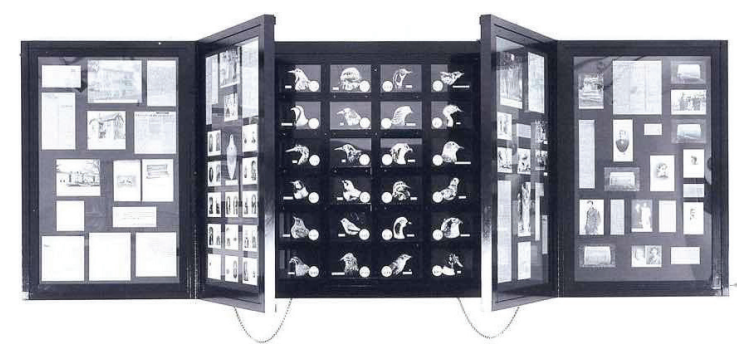
Edward J. Couch’s collection of birds led to the Ridgefield Historical Society’s acquisition of the Couch collection, although, unfortunately, the taxidermied birds have disappeared. Their last known location was Ridgefield’s Center School.
A story in the Oct. 5, 1933 Ridgefield Press had reported, “Couch Collection Formally Given Center School — Outstanding Collection of Wild Bird Specimens Presented at School Exercises.” The indefinite loan of the collection, said to include two carrier pigeons as well as a “Golden Eagle from the Farmingville section, and a white rat from a South Norwalk factory,” was made by Miss Margaret C. Beazell, Couch’s granddaughter, who was then “sketching in Yorkshire, England.”
The mystery of the birds
An exhibit at the Aldrich Contemporary Art Museum of Ridgefield that was organized in 1999 inspired artist Bill Barrette of New York City to begin a quest to track down the birds. The Center School was torn down in 1955 and there were no records of the bird collection ever being returned to the Couch descendants. Margaret Beazel Asson, who loaned the birds to the school, sold the family home in Ridgefield in 1966 and at that time donated a large collection of women’s clothing from the 19th Century to the Keeler Tavern Museum; there was no mention of the birds, nor did her estate list the collection.
In his research, Mr. Barrette enlisted the help of Jeanne Timpanelli and reached out to sources that eventually led to a distant relative of Edward J. Couch in King of Prussia, Pa. David Freeman shared the collection of materials from eight generations of the Couch family with Mr. Barrette and agreed to donate the material to the planned Ridgefield Historical Society, in care of Mrs. Timpanelli.
While his search for the original taxidermied birds went unfulfilled, Bill Barrette’s entry in the exhibit Playing Off Time at the Aldrich Museum, styled as a “cabinet of curiosities,” was a tribute to the Couch family and its history, which, he told The Ridgefield Press, was the point. His work, The Bird Collector, “wasn’t just the birds that I was interested in, it was what they represented,” which turned out to be a family whose roots in Connecticut history went back to the late 1600s.
And that family’s history, plus Mr. Barrette’s work (purchased by an anonymous donor), are part of the permanent collection at the Ridgefield Historical Society.
The West Lane/Peter Parley Schoolhouse: A lasting legacy of the Ridgefield Garden Club
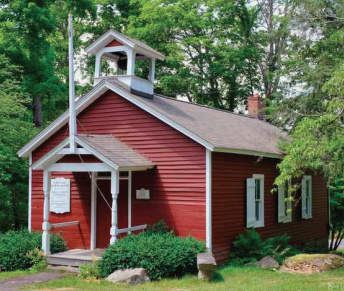
The Ridgefield Garden Club’s formal connection with the Peter Parley Schoolhouse and its grounds ended this spring after many years, but the legacy of the club’s involvement is a continuing gift to Ridgefield. Members over the years were responsible for both the interior of the school as well as the grounds, turning a mostly abandoned building into an attractive landmark as well as a museum of early education in Ridgefield.
In her 2011 annual report on the Peter Parley Schoolhouse, Ridgefield Garden Club member Donna Warren wrote:
“Fifty years ago this month, Ridgefield Garden Club signed a contract with the town committing to maintain the Peter Parley Schoolhouse on West Lane. What an undertaking that was! There was no electricity, no heat, no plumbing. In addition, the schoolhouse needed a new roof and a new coat of paint. The interior had become a storage area for the town and was in a state of disrepair. It had not been used since 1915…
“There were a few ladies in the garden club who … put their hearts and souls into restoring the schoolhouse so that it could become a part of Ridgefield history. These ladies persevered and accomplished what they set out to do. They were able to convince many local businesses to contribute their time and resources in painting and roofing and digging a basement to accommodate a fuel oil tank.
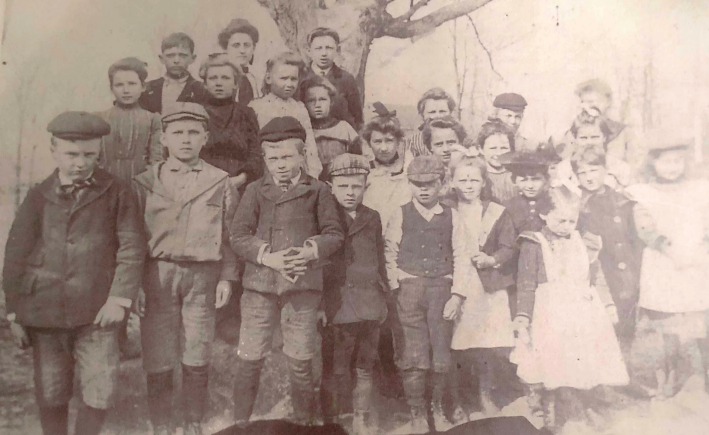
“During the last fifty years, the garden club has faithfully maintained the building and has opened the doors to visitors several times during the summer months. The docents have been volunteers from the garden club who donated their time and energy to instill in both children and adults a sense of the history of Ridgefield.”
Ms. Warren’s report went on to explain that the Ridgefield Historical Society had proposed taking on the care of the schoolhouse and, with the Ridgefield Garden Club and the Town, was in the process of drawing up papers to put that into effect.
Mrs. Warren and Sharon Dunphy, another Ridgefield Garden Club member, who had been overseeing the schoolhouse and adding to its furnishings and historical materials, continued to serve in those roles with the Historical Society, introducing visitors to the one-room school experience with monthly open houses May-October.
Mrs. Dunphy went on to be elected president of the Ridgefield Historical Society and Mrs. Warren retired from schoolhouse duties in 2019. They were succeeded by volunteers Jack and Sally Sanders, neighbors of the schoolhouse; he is the author of many books on Ridgefield history and she is a member of the board of the Ridgefield Historical Society.
The Peter Parley Schoolhouse these days continues to welcome visitors, with a classroom that looks much as it did when the school closed in 1915. On the last Sunday of May through October, visitors still delight in ringing its bell and learning about a piece of Ridgefield history. Ridgefield Historical Society volunteers now staff the open houses and carry on the Ridgefield Garden Club tradition of celebrating Peter Parley’s (Samuel G. Goodrich) birthday in August, with lemonade and treats.
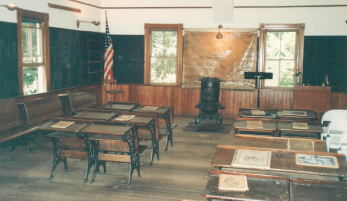
The Ridgefield Garden Club once hosted Ridgefield grade school students on visits that were part of a local history curriculum; this year, thanks to retired teachers Dr. Darla Shaw and B.G. Brown, the
Farmingville School third grades had an early 19th Century experience at the schoolhouse. The pre-kindergarten students from the Creative Children’s Korner (CCK) also visited and explored the schoolhouse. (Coincidentally, CCK was founded in 1967 by Ethelyn Pinchbeck, whose father-in-law, Joseph G. Pinchbeck, was once a student at the Peter Parley/West Lane District School.)
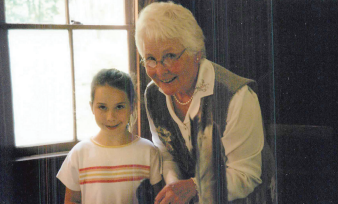
The Ridgefield Historical Society is grateful for the countless hours of work done by Ridgefield Garden Club volunteers over the years, both inside the Peter Parley Schoolhouse and on its grounds. We will continue to honor and share those efforts as we welcome visitors to the little red schoolhouse by the side of the road.
The Scott House Journal (SHJ) is a quarterly publication, sharing stories of Ridgefield past. It is written by Sally Sanders, Historical Society Board member and former arts editor
